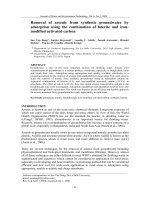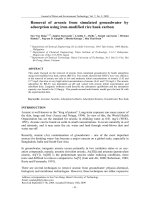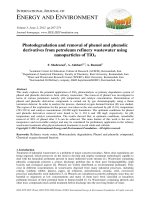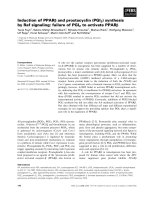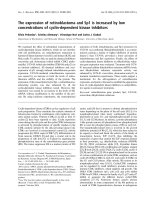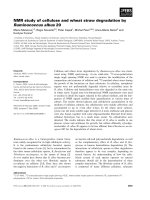simultaneous removal of arsenic and ammonia from groundwater by phytofiltration with cattails (typha spp.) cultivation
Bạn đang xem bản rút gọn của tài liệu. Xem và tải ngay bản đầy đủ của tài liệu tại đây (1.27 MB, 63 trang )
3
TABLE OF CONTENTS
TABLE OF CONTENTS
1
ABBREVIATIONS
3
LIST OF FIGURES
4
LIST OF TABLES
5
LIST OF DIAGRAMS / FLOWCHARTS
5
ACKNOWLEDMENTS
6
INTRODUCTION
7
CHAPTER 1- OVERVIEW
10
1.1. Water Sources and Quality Requirements for Drinking Purpose
10
1.1.1. Water sources:
10
1.1.2. Groundwater Quality Requirements for Drinking Purpose
10
1.2. Current Status of Ammonia and Arsenic Contamination of
Groundwater
11
1.2.1. Arsenic Contamination of Groundwater:
11
1.2.2. Ammonia Contamination of Groundwater:
16
1.3. Treatment Technologies
17
1.3.1. Arsenic Removal Treatment:
17
1.3.2. Ammonia Removal from Groundwater
19
1.4. Phytofiltration Systems
21
1.4.1. Characteristics of Phytofiltration Systems
21
1.4.2. Principles of Phytofiltration Systems
23
CHAPTER 2 - MATERIALS AND METHODS
28
2.1. Plant Selection:
28
2.2. Soil Selection for Rooting Media:
29
2.3. Setup and Operation of Phytofiltration Systems:
29
2.3.1. Plant Cultivation:
29
4
2.3.2. Operation:
29
2.3.3. Preparation of Ammonia and Arsenic Solutions
31
2.4. Sampling:
31
2.5. Chemical analysis of samples [APHS, 1970]:
31
2.5.1. pH-value measurement
31
2.5.2. Alkalinity determination
31
2.5.3. Ammonia-nitrogen analysis
32
2.5.4. Nitrite-nitrogen analysis
34
2.5.5. Nitrate-nitrogen analysis
36
2.5.6. Arsenic analysis
37
CHAPTER 3 - RESULTS AND DISCUSSIONS
40
3.1. Biomass Accretion of Cattails (Typha spp.)
40
3.2. Arsenic Removal Effectiveness
42
3.3. Ammonia Removal Effectiveness
44
3.3.1. Ammonium-Nitrogen:
44
3.3.2. Nitrite-Nitrogen:
48
3.3.3. Nitrate-Nitrogen:
49
CONCLUSIONS
51
RECOMMENDATION AND PROSPECT
53
REFERENCES
56
APPENDIX
61
5
ABBREVIATION
APHA
American Public Health Association
ATSDR
Agency for Toxic Substances and Disease Registry
CETASD
Center for Environmental Technology and Sustainable Development
FAO
Food and Agriculture Organization
HUS
Hanoi University of Science
MCL
Maximum Concentration Limit
MONRE
Ministry of Natural Resource and Environment
NRC
National Research Council
TCVN
The Vietnamese Standard
US EPA
The United Stated Environmental Protection Agency
WEPA
Water Environment Partnership in Asia
WHO
World Health Organization
6
LIST OF FIGURES
Figure 1.1
Tentative risk map of arsenic concentrations in groundwater of
the Red River Delta
13
Figure 1.2
Expressions of the black foot disease
15
Figure 1.3
Situation of ammonia contamination of groundwater in Hanoi City
16
Figure 1.4
Arsenic Removal Mechanisms in a Phytofiltration System
25
Figure 2.1
Cattails (Typha spp.)
28
Figure 2.2
Cross section of an phytofiltration system with cattails (Typha
spp.) cultivation.
30
Figure 3.1
Biomass accretion of cattails after periods of transplanting time
40
Figure 3.2
Root accretion of cattails after periods of transplanting time
41
Figure 3.3
Loading rates on arsenic
42
Figure 3.4
[As] in outflows after periods of treatment time
43
Figure 3.5
Loading rates on ammonia (mg/d)
45
Figure 3.6
[NH
4
+
-N] in inflows and outflows after periods of treatment time
47
Figure 3.7
[NO
2
-
-N] in outflows after periods of treatment time
49
Figure 3.8
[NO
3
-
-N] in outflows after periods of treatment time
50
Figure 5.1
Sequentially assembled phytofiltration systems with cattails
(Typha spp.) cultivation.
54
Figure 8.1
Distribution of documented world problems with arsenic in
groundwater in major aquifers as well as water and environmental
problems related to mining and geothermal sources.
61
Figure 8.2
Evaluation of simultaneous removal of arsenic and ammonia via
hydroponically transplanted plants
64
7
LIST OF TABLES
Table 1.1
MCL values for arsenic in drinking water
10
Table 1.2
Average arsenic concentrations and ranges in sample collected in
rural districts in the Red River Delta in 2001
13
Table 1.3
Average arsenic concentrations and ranges in sample collected in
the Mekong Delta on July, 2004 (n = 112)
14
Table 1.4
Average NH
4
+
-N and NO
2
-
-N concentrations and ranges in
samples collected in 2004 in the Mekong River Delta
17
Table 1.5
The seven states of oxidation in which nitrogen can exist
19
Table 2.1
Initial concentrations of ammonia and arsenic in inflows
31
Table 2.2
Daily-taken volumes of outflow samples
31
Table 3.1
Front accretion of cattails after periods of transplanting time
(n=6)
41
Table 8.1
Classification of nitrogen compounds pollution levels in
groundwater in general
61
Table 8.2
Major arsenic minerals occurring in nature
62
Table 8.3
Ammonium-Nitrogen Concentrations in several rivers in the
North of Vietnam (in 2004)
33
Table 8.4
Values of K
a
(Ionization constant in the ammonia and
ammonium equilibrium) dependent on Temperature
33
Table 8.5
Loading rates on arsenic and ammonia of some plants
transplanted hydroponically in arsenic- and ammonia-
contaminated water
64
Table 8.6
Experimental Results
65
LIST OF DIAGRAMS / FLOWCHARTS
Flowchart 5.1
Potential applications of phytofiltration for arsenic-
contaminated soil and water
55
9
INTRODUCTION
Groundwater in Vietnam is abundant; however, it is often polluted by different
contaminants, especially by arsenic and ammonia [WB, 2002]. The frequency of
ammonia-contaminated groundwater demonstration in the Red River Delta areas is
approximately 80% - 90% with average ammonia concentrations ranging from 10
mg/L – 30 mg/L [Le Van Cat, Tran Mai Phuong, 2005]. In the Mekong River Delta,
ammonia contamination of groundwater is also alarming with average ammonia
concentrations ranging from 0.1 - 35 mg/L [M. Berg, 2006]. Ammonia does not
directly cause poisoning, but unfortunately, its transformed products (such as nitrite
NO
2
-
, nitrate NO
3
-
) can cause health risks to human beings [US EPA, 2000].
Besides, groundwater in Vietnam is significantly polluted by arsenic [WB, 2002].
The levels of arsenic contamination were examined and varied from 1 µg/L to 3050
µg/L (48% above 50 µg/L and 20% above 150 µg/L) in groundwater samples from
domestic shallow tube-wells in rural areas in the Red River Delta. Particularly, of
which, the groundwater used directly as drinking water source had an average
concentration of 430 µg/L in several highly affected rural areas [Tran Hong Con,
2006]. In the Mekong River Delta, arsenic concentrations in groundwater are also
high in range from 1 µg/L to 845 µg/L [M. Berg et al., 2006]
Actually, such high arsenic- and ammonia-contaminated groundwater indicates that
millions of people, especially who are living in the Red River Delta and in the
Mekong River Delta daily consuming untreated groundwater, might be at high
considerable health risks of poisoning caused by such contaminated groundwater.
Treatment technologies for arsenic and/or ammonia removal from contaminated
groundwater have been paid much attention and concern. There are several current
treatment technologies for ammonia removal from groundwater such as Breakpoint
Chlorination, Ion Exchange by Clinoptilolite, Air-stripping [Le Van Cat, 2007].
Main methodologies for arsenic removal include Precipitation, Adsorption, Ion
10
Exchange by Activated γ-Al
2
O
3
[US EPA, 2000]. However, selection of an
optimal treatment technology depends on both objective and subjective factors, for
example, contaminant contents, economic conditions, treatment scales,
availability While precipitation is the most common among such methods, the
disadvantage is that it only reduces the dissolved metal concentration to the
solubility product level, which is frequently out of compliance with rigorous
discharge permit standards and thus requires additional cleaning stages.
These aforementioned techniques are all generally expensive and might possibly
generate by-products dangerous to human health [US EPA, 2000]. Regarding to
rural areas conditions, the priority factors which should be much taken into account
are costs and treatment scales. Applications of these technologies for small-scale
treatments are certainly more difficult in comparison to those for large-scales in
point of views of financial problems, operation and maintenance conditions.
In Vietnam, several studies on removal of arsenic and ammonia from contaminated
groundwater have been researched and implemented in recent years. However,
applications of the above-mentioned technologies often faces difficulties and
disadvantages such as high costs, complicated operation and maintenance skills In
addition, each of these treatment technologies can be compatible for partially
removing one contaminant. Thus, simultaneous removal of contaminants requires a
series of sophisticatedly combined treatment systems. An optimal treatment
technology which can be broadly applied in rural areas must be considered in terms
of low cost, small-scale treatment, simple operation and maintenance Moreover,
requirements of simultaneous removal of both arsenic and ammonia should
necessarily be taken into account.
Phytofiltration system, a plant-based technology for the removal of toxic
contaminants from soil and water, has been receiving renewed attention. A great
deal of research in decades that plants have the genetic potential to remove many
toxic contaminants from water and soil [R.L. Chaney et al., 2000]. Plants can
11
uptake nutrients for their biomass development and growth. Moreover, plants can
transport oxygen from the air through their leaves, their shoots and finally to their
root-zones for aerobic microorganisms to carry out nitrification and denitrification,
with presence of ammonia as a preferable nutrient source. Ammonia will be
transformed to gaseous nitrogen (non-toxic) and to escape to the air. In addition,
plants have metals-accumulating ability to build their own cellular matters via
uptake process. Consequently, arsenic and ammonia will be removed from
groundwater after periods of time.
Phytofiltration has been proposed as a cost-effective, environmental-friendly
alternative technology. A number of plants have been identified for the
phytofiltration, and some have been used in practical applications. In this study,
cattails (Typha spp.) were chosen as a model plant for the phytofiltration systems
because of its high arsenic-accumulating ability coupled with its rapid growth and
generation of high biomass yields. This finding may open a door for phytofiltration
of ammonia and arsenic-contaminated groundwater in Vietnam.
This study aims at:
1. Examining simultaneous removal ability of ammonia and arsenic from
contaminated water by three pilot phytofiltration systems with cattails
(Typha spp.) cultivation;
2. Constructing and developing an optimal treatment technology for
simultaneous removal of ammonia and arsenic (and other contaminants)
from groundwater for drinking uses.
12
CHAPTER 1 - OVERVIEW
1.1. Water Sources and Quality Requirements for Drinking Purpose
1.1.1. Water sources:
In Vietnam, the water sources exploited and used for domestic purposes are mainly
from surface water and groundwater. Surface water source is abundant, mainly from
rivers, lakes, ponds It is commonly recharged with rainwater, shallow-level
groundwater, and wastewater. Moreover, surface water quality is often affected by
human life activities such as agriculture, industries. Nowadays, surface water does
gradually not meet basic requirements for domestic purposes if it is not treated
before use. Besides, groundwater quality is somewhat better than that of surface
water in general. However, groundwater sources are also gradually polluted by both
natural and anthropogenic contamination sources.
1.1.2. Groundwater Quality Requirements for Drinking Purpose
a/ Arsenic MCL Standard for Drinking Water:
The MCL for arsenic in drinking water according to several standards are shown in
Table 1.1:
Table 1.1 - MCL values for arsenic in drinking water [J. Matschullat, 2000]
Standard
WHO*
EU
NL
TVO-D
DVGW
TCVN
[As] (µg/L)
10
50
10 - 60
10
10 - 30
10
▪ WHO: World Health Organization, drinking water guidelines for arsenic;
▪ EU: European Union;
▪ NL: Dutch drinking water guidelines for arsenic (the first numbers refer to
reference values, the second to maximum permissible levels);
▪ TVO-D: German drinking water standards for arsenic;
13
▪ DVGW: German surface water (raw water) guidelines (for ranges see NL);
▪ TCVN: Vietnamese Standards
b/ Ammonia MCL Standard for Drinking Water:
Ammonia MCL standards for drinking water in somewhere around the world are
different. The WHO and EU standards for ammonia MCL in drinking water is of
0.5 mg/L. Whereas, Vietnamese standard has set a limit for ammonia-nitrogen MCL
in drinking water is 3 mg/L according to new TCVN 5520-2003 [TCVN, 2003].
1.2. Current Status of Ammonia and Arsenic Contamination of Groundwater
1.2.1. Arsenic Contamination of Groundwater:
a/ Arsenic Contamination:
Arsenic, a significant contaminant of groundwater, has been found in many regions
around the world [P.L. Smedley and D.G. Kinniburgh, 2002]. Arsenic is widely
known for its adverse effects on human health, affecting millions of people. High
concentrations of arsenic (above 50 g/L) in groundwater used as drinking water
source have been reported in several countries such as Bangladesh, India, China,
Mexico, Nepal, Taiwan, Vietnam…
In some Asian countries, arsenic in groundwater is a major health concern and the
risks from using shallow tube-wells (STWs) for drinking water are well-known. As
part of the green revolution, millions of STWs have been installed throughout Asia
over the last three decades. This has resulted in a sharp increase of groundwater
extraction for irrigation. The direct consumption of groundwater through tube-wells
in an attempt to replace polluted surface water supplies has resulted in widespread
arsenic poisoning.
a1/ Sources of arsenic contamination:
Arsenic is one of the most toxic elements encountered in the environment. Arsenic
can enter groundwater through both natural geologic processes (geogenic) and
14
anthropogenic activities. The primary anthropogenic contributions of arsenic to
groundwater are from application of arsenical pesticides, irrigation, mining and
smelting of arsenic-containing ores, combustion of fossil fuels (especially coal),
land filling of industrial wastes, release or disposal of chemical warfare agents
[K.H. Goh and T.T. Lim, 2005], manufacturing of metals and alloys, petroleum
refining, and pharmaceutical manufacturing [R.Y. Ning, 2002] Another potential
contributing source of arsenic in groundwater is the current use of chromated
copper arsenate (CCA) as wood preservative. Organic arsenic is also a constituent
of feed additives for poultry and swine for the control of coccidian intestinal
parasites and to improve feed efficiency, and appears to concentrate in the resultant
animal wastes. There is a significant use of arsenic in the production of lead-acid
batteries, while small amounts of very pure arsenic are used to produce gallium
arsenide, which is a semi-conductor used in computers and other electronic
applications [R.Y. Ning, 2002]. Even though industrial use of arsenic has decreased
in recent years, it remains a significant arsenic contamination source of groundwater
for some human health problems [M. Karim, 2000].
a2/ Arsenic contamination of groundwater in Vietnam:
Groundwater in the two large alluvial deltas of Mekong River and Red River has
been exploited for domestic uses by private tube-wells [M. Berg et al., 2006]. M.
Berg et al., (2006) found that the arsenic concentrations in groundwater somewhere
in the Mekong River Delta and Red River Delta range from 1 to 845 µg/L and from
1 to 3050 µg/L, respectively. Whereas, Trang et al., (2006) found elevated arsenic
concentrations in areas of the Mekong Delta, where 405 (40%) of the tube-wells
had arsenic levels higher than 100 µg/L.
A tentative risk map of arsenic being higher than 50 µg/L in groundwater of the Red
River Delta is presented in Figure 1.1. This map was established from geological
raster information, climate and land use.
15
Figure 1.1 - Tentative risk map of arsenic concentrations in groundwater of the
Red River Delta [FAO, 2007]
Table 1.2 - Average arsenic concentrations and ranges in sample collected in
rural districts in the Red River Delta in 2001 [M. Berg et al., 2006]
Rural Districts
n
Average (µg/L)
Range (µg/L)
A
48
32
1 – 220
B
48
67
1 – 230
C
55
140
2 – 3050
D
45
430
2 – 3010
SUMMARY
196
159
1 – 3050
16
Table 1.3 - Average arsenic concentrations and ranges in sample collected in
the Mekong Delta on July, 2004 (n = 112) [M. Berg et al., 2006]
Average
Median
Range
Arsenic concentratioin (µg/L)
in the Mekong Delta
39
< 1
1 – 845
In Vietnam, the aquifers under the large deltas of Mekong River and Red River are
now widely exploited for drinking water and for agricultural uses. These above-
presented data are demonstrating that people living in the two deltas are chronically
exposed to elevated arsenic levels in groundwater used as their drinking water
source via broadly-distributed tube-well system and at high risk of arsenic
contamination. The total number of tube-wells in the two regions is unknown but
could be over one million [P.L. Smedley and D.G. Kinniburgh, 2002]. It means that
millions of people in Vietnam are likely to be affected by using contaminated
groundwater from tube-wells and through consumption of contaminated foods.
Unfortunately, symptoms of chronic arsenic poisoning usually take more time than
ten years to develop and appear, the number of future arsenic related ailments in
Vietnam, therefore, is likely to increase. Urgently, early mitigation measures should
be a high priority.
b/ Arsenic Toxicity
b1/ Arsenic speciation:
Arsenic can be present in groundwater as chemical compounds of both inorganic
and organic forms, which include elemental arsenic, arsenide, sulphide, oxides,
arsenates and arsenite [E. Miteva et al., 2005]. A list of some of the most common
arsenic compounds is given in Table 8.2. Among them, arsenate As(V) and arsenite
As (III) are the most abundant [M.B. Hossain, 2005].
17
b2/ Arsenicosis:
Arsenic contamination of water supplies poses serious risks to human health
because inorganic arsenic is a known carcinogen and mutagen, and is detrimental to
the human immune system [NRC, 2001]. Drinking water and/or obtaining foods
rich in arsenic over a long period lead to arsenicosis. Chronic levels of 50 µg/L of
arsenic can cause health problems after 10 to 15 years of exposure. The
development of symptoms of arsenicosis is strongly dependent on exposure time
and the resulting accumulation in the body. The various stages of arsenicosis are
characterized by skin pigmentation, keratosis, skin cancer, effects on the
cardiovascular and nervous system, and increased risk of lung, kidney and bladder
cancer [H.M. Anawar et al., 2002].
In China, exposure to arsenic via drinking-water has been shown to cause a severe
disease of the blood vessels known as “black foot disease” [M.M. Wu, 1989].
Figure 1.2 - Expressions of the black foot disease (WHO 00229, 2007)
b3/ Arsenicosis causes:
Arsenicosis is caused by the chemical arsenic, especially inorganic arsenic. Arsenic
is a toxic element that has no apparent beneficial health effects for humans.
Arsenicosis is caused by exposure over a period of time to high arsenic
18
concentrations in drinking water. Besides, it may also be due to intake of arsenic via
food or air. The multiple routes of arsenic exposure contribute to chronic poisoning
[WHO, 2001].
1.2.2. Ammonia Contamination of Groundwater:
a/ Ammonia Contamination:
Researches on ammonia contamination of groundwater, especially in the Red River
Delta, have been paid much attention [WB, 2002]. A few initial results have been
achieved to evidently demonstrate and alarm such high ammonia contamination of
groundwater in Vietnam.
As shown in Figure 1.3 it is the situation of ammonia contamination of groundwater
in several sites of Hanoi City:
Figure 1.3 - Situation of ammonia contamination of groundwater in Hanoi City
[CETASD, 2004]
Investigated sites:
HD: Ha Dinh
LY: Luong Yen
MD: Mai Dich
NSL Ngo Sy Lien
NH: Ngoc Ha
PV: Phap Van
TM: Tuong Mai
YP: Yen Phu
19
As presented, groundwater in several sites of Hanoi City is strongly affected with
high ammonia concentrations, especially in Ha Dinh and Phap Van areas with
ammonia concentrations of higher 10 mg/L (shown in red color).
In the Mekong River Delta, ammonia contamination of groundwater is also
alarming. M. Berg et al., 2006 researched and found demonstrations of ammonia
contaminations of groundwater as shown in Table 1.4 below:
Table 1.4 - Average NH
4
+
-N and NO
2
-
-N concentrations and ranges in samples
collected in 2004 in the Mekong River Delta [M. Berg et al., 2006]
Average
Range
NH
4
+
-N concentration (mg/L)
5.0
0.1 - 35
NO
2
-
-N concentratioin (mg/L)
0.25
0.25 – 4.4
*/ Ammonia contamination sources of groundwater can be from both natural and
anthropogenic sources. Natural sources include biological fixation of atmospheric
nitrogen which serves as a significant source of natural nitrogen input to water.
Anthropogenic sources include uses of chemical fertilizers, pesticides, run-off,
industrial discharges, etc. [ATSDR, 2004].
b/ Ammonia Toxicity:
There has no scientific report told that ammonia affects directly to human health but
transformed products made from ammonia like nitrite, nitrate via nitrification and
denitrification are very dangerous [ATSDR, 2004]. Nitrite can combine with
secondary amines in the digestive tract to produce N-nitrosamine which is
carcinogenic. And, nitrate is agent created bluish coloration of the skin
NH
4
+
→ NO
2
-
→ NO
3
-
(a)
1.3. Treatment Technologies
1.3.1. Arsenic Removal Treatment:
20
The most common water treatment technologies for arsenic-contaminated water
include the following:
a/ Coagulation/Filtration:
Coagulation/filtration removes arsenic by co-precipitation with iron oxide [US
EPA, 2002]. Coagulation/filtration using alum is already used by some utilities to
remove suspended solids, and may be adjusted to remove arsenic. Iron oxide
adsorption filters the water through a granular medium containing ferric oxide.
Ferric oxide has a high affinity for adsorbing dissolved metals such as arsenic [US
EPA, 2002]. The iron oxide medium eventually becomes saturated, and must be
replaced.
This treatment method is effective for removal of As(V) according to lab- and pilot-
plant tests. However, it is generally unable to successfully remove arsenic in large-
scale system to lower levels due to the affinity and solubility limitation of the
resultant products [US EPA, 2002]. The procedures are also time-consuming and
expensive, and not cost-effective. And another disadvantage of this method is the
generation of large volumes of arsenic-contaminated coagulation sludge [US EPA,
2002]. The disposal of such contaminant wastes may be a concern, especially if
nearby landfills are unwilling to accept such sludge.
b/ Lime Softening:
This method for removing dissolved arsenic from groundwater is comprised of the
following steps [US EPA, 2002]:
1. Adding lime to the aqueous medium, wherein the step of adding lime increases
the pH of the aqueous medium to at most approximately 10; and
2. Adding one or more sources of divalent metal ions other than calcium and
magnesium to the aqueous medium wherein said metal ions comprise one or
more sources of copper ions or zinc ions;
21
3. Wherein substantially no ferric ions are added to the aqueous medium; and
whereby dissolved arsenic in the aqueous medium is reduced to a lower level
than possible if only the step of adding lime were performed.
1.3.2. Ammonia Removal from Groundwater
a/ Biological-nitrogen species:
In nature, nitrogen-compounds can be existed in many states of oxidation, ranging
from reduced ammonia – nitrogen (NH
3
-N)/ammonium – nitrogen (NH
4
+
-N) to
highly oxidized nitrates-nitrogen (NO
3
-
-N). In all, nitrogen can exist in seven states
of oxidation, as shown in Table 1.5:
Table 1.5 – The seven states of oxidation in which nitrogen can exist
[Le Van Cat, 2007)
Compound
Formula
Valence
Ammonia – nitrogen /
Ammonium – nitrogen
NH
3
-N / NH
4
+
-N
-3
Nitrogen gas
N
2
0
Nitrous oxide
N
2
O
+1
Nitric oxide
NO
+2
Nitrite – nitrogen
NO
2
-
-N
+3
Nitrogen dioxide
NO
2
-
+4
Nitrate – nitrogen
NO
3
-
-N
+5
b/ Ammonia Removal from Groundwater:
In water, ammonia/ammonium and nitrate are more abundant than nitrite and other
organic nitrogen-compounds. At aim of an achievement of the most effective
ammonia removal technology from groundwater, such technology should be a
22
complete transformation of the nitrogen-compounds finally into gaseous nitrogen,
which is inert and does not pollute environment.
Based on this principle, physiochemical and/or biological treatments can be applied
for removal of nitrogen-compounds from groundwater as follows:
b1/ Transformation of the nitrogen-compounds finally into gaseous nitrogen which
then releases to the air. This method is due to the following processes:
Biological processes (Nitrification and Denitrification);
o Nitrification: Ammonium is converted into nitrite, and finally to nitrate.
The bacteria involved are autotrophic and use oxygen as their electron
acceptor, whereas ammonium is used as their substrate. The conversion
to nitrite is performed by Nitrosomonas sp; and the conversion to nitrate
by Nitrobacter sp. These bacteria are obligate aerobes, meaning that they
can grow only in the environment in which dissolved oxygen (DO) is
present. If the absence of DO for prolonged periods, however, is not
lethal to those microorganisms [H.A. Painter, 1970].
o Denitrification: In the absence of dissolved oxygen, bacteria will use
nitrate as a terminal electron acceptor and convert nitrate to nitrogen gas.
Anamox process (Oxidation/Reduction of ammonia via microorganism
activities);
Direct oxidation of ammonia to form gaseous nitrogen;
b2/ Transformation of the nitrogen-compounds into cellular components (biomass
of plants and microorganisms)
These transformations are involved in biochemical reactions occurring in plant
cells (via photosynthesis reactions) and microorganism cells (via assimilation
reactions). These processes exist in nature.
b3/ Volatilization of ammonia into the air.
23
Treatment cost-effectiveness these methods are certainly different. An optimal
selection of treatment technology should be based on cost-effectiveness (low
operation and maintenance cost, simple handling ) and treatability (long-life,
maximum elimination of not only ammonia but other contaminants )
1.4. Phytofiltration Systems
1.4.1. Characteristics of Phytofiltration Systems
a/ Phytofiltration:
Phytofiltration, the use of plant with extensive root systems and high accumulation
capacity for contaminants, to absorb and adsorb pollutants from water and streams,
is gaining a lot of importance in recent times since it is a cost-effective, promising
and environmentally-friendly technology [D.E. Salt et al., 1995].
b/ Main Components of Phytofiltration Systems: The three main components of
a phytofiltration system are hydrology, soils/sediments, and vegetation. The
interactions of these components dictate the overall contaminant removal efficiency
of the phytofiltration systems.
1. Hydrology: Hydrologic regime is the major regulating factor of all
phytofiltration systems used for water treatment. Hydrologic characteristics
depend on configuration or geometry of phytofiltration systems, water loading
rate, and water depth.
2. Soil substrate for rooting media: The type and textile of soil affect physical,
chemical, and biological mechanisms regulating the removal of contaminants
from water. Soil characteristics which should be taken into account are soil pH,
soil penetrability, and soil thickness Of which, soil penetrability, soil thickness
are important factors in soil selection. Soil vertical penetrability is dependent on
the type and textile of soil. Sandy soil has high spongy textile which is
supportive for penetration.
24
In many phytofiltration systems, the soil layer is upper-lain by a small pebble
layer to prevent water sampling from being blocked.
3. Vegetation: The following factors should be taken into account in the plant
selection:
▪ High capability of nutrient storage and uptake;
▪ High capability of transporting oxygen from the air to the rhizosphere;
▪ High resistibility to water and climatic conditions;
▪ Low sensitivity to various chemical components in soil and water;
▪ High growth rate and multiplication (high biomass production).
Herbaceous emergent macrophytes have been demonstrated and applied in many
phytofiltration systems because many of these plants are perennial and have a high
capacity of biomass production and contaminant storage [R.R. Brooks, 1998]. They
are widely distributed on the shorelines of lakes and streams and in wetland
ecosystems. The emergent macrophytes most typically used in phytofiltration
systems include cattails (Typha spp.), reeds (Phragmites sp.), and bulrush (Scirpus
spp.) [R.R. Brooks, 1998]. These emergent macrophytes, especially cattails (Typha
spp.), are potentially available in Vietnam.
c/ Physicochemical Characteristics of Phytofiltration Systems:
Emergent macrophytes can easily transport oxygen through their stems and leaves
into their root zone. Oxygen not used during root respiration may leak into the
adjacent soil, creating an aerobic zone around the roots. The excess oxygen in
rhizosphere may be significant in the aerobic oxidation of soluble organic
compounds and nitrification of ammonia-nitrogen/ammonium-nitrogen. Field
studies with and without plants give the most reliable estimates of oxygen available
to bacteria in the rhizosphere. Although there is clear evidence of oxygen transport
into the roots by diffusion and mass flow, at times oxygen transport may be
25
insufficient to meet plant metabolic requirements, implying that there is no enough
oxygen to significantly affect water treatment processes.
1.4.2/ Principles of Phytofiltration Systems
a/ Nutrient Storage and Uptake Capacity of Plants:
The nutrient removal capacity of an phytofiltration system is dependent on plant
growth rates, contaminant content and bioavailability, sediment characteristics,
oxygen transfer capacity of the plants into the root-zone, biochemical and
physiochemical processes functioning at the root-water-sediment interface, plant
density per unit area, plant harvesting, and climatic conditions
Nutrient uptake rates and maximum growth rates define the nutrient storage
capacity of the plant. The potential rate of nutrient uptake by a plant is limited by its
net productivity (growth rate) and the concentration of nutrients in the plant tissues.
Nutrient storage is dependent on plant tissue nutrient concentrations and on the
potential for biomass accumulation (that is, the maximum standing crop - biomass
per unit area). Maximum growth typically is attained at the lower range of nutrient
supply, whereas maximum nutrient uptake rate is reached at much higher levels of
nutrients.
b/ Mechanisms of Arsenic Uptake and Accumulation in Plants
- / Arsenic speciation and distribution can provide important information helpful to
understanding the mechanisms for arsenic accumulation, translocation, and
transformation in plants. The two most important forms, As(V) and As(III), are
taken up to plants by completely different mechanisms. Uptake, accumulation and
toxicity vary within and between plant species. In general, more arsenic in the soil
and water leads to higher concentrations in plants, but this depends on many other
factors.
Arsenic is a nonessential element for plant growth. At higher concentrations, arsenic
interferes with plant metabolic processes and can inhibit growth, often leading to
26
death. However, during evolution plants have developed two strategies that enable
them to survive and reproduce in arsenic enriched environment: arsenic exclusion
and arsenic accumulation [H. Dahmani-Muller et al., 2000].
Successful application of phytofiltration systems to arsenic-contaminated soils and
water depends on many factors, among which are plant biomass and arsenic
concentrations. Plants must be able to produce sufficient biomass while
accumulating a high concentration of arsenic. In addition, plant species should be
responsive to agricultural practices designed to enhance arsenic accumulation and to
allow repeated planting and harvesting of arsenic-rich biomass. Furthermore, it is
important to understand the availability and phytotoxicity of arsenic to the plant
itself.
-/ Uptake: Arsenic in soil and water is found to be predominantly as inorganic
species. It was hypothesized that the plant uptakes arsenic as arsenate As(V) and
then arsenate is converted to arsenite As(III) within the plant [W. Zhang et al.,
2002]. Arsenate and arsenite are taken up by different mechanisms. Abedin et al.,
(2002) suggested that the plants were effectively exposed to As(III) and not to
As(V) because of the reducing soil conditions. The uptake mechanism of organic
arsenic is largely unclear so far.
-/ Translocation and accumulation: Organic arsenic is more readily translocated but
the uptake is much lower compared to inorganic arsenic. For example, in pot
experiments with rice plants exposed to arsenic added via arsenate in irrigation
water, rice plant parts were ranked according to the arsenic concentrations as
follows: root > straw > husk > grain [Carbonell et al., 1998]. Concentrations in all
plant parts increased with the exposure concentration. This is a common
observation for other plants as well [B.M Bleeker, 2003].
-/ Metabolism: After uptake, arsenate is rapidly reduced to arsenite, causing
oxidative stress. This induces the formation of certain anti-oxidants. This is
regarded as a detoxification mechanism [A.A. Meharg and J. Harley-Whitaker,
27
2002]. In spite of the rapid reduction of arsenate to arsenite, high levels of arsenate
have also been found in plant material. Abedin et al., (2002) reported that more than
70 percent of the arsenic in the straw of rice was present as arsenate. Schmidt et al.,
(2004) found arsenate in plants that were only exposed to arsenite, showing that
oxidation of arsenite in plants also took place. Many organic arsenic species have
been found in plants as well, but only in minor amounts [V.M. Dembitsky and T.
Rezanka, 2003].
c/ Mechanisms of Ammonia Uptake and Accumulation in Plants
Nitrogen-compound removal processes in phytofiltration systems include
nitrification and denitrification, ammonia volatilization (little) and plant uptake.
These processes aid in maintaining low levels of inorganic nitrogen in the water
Figure 1.4 – Arsenic Removal Mechanisms in a Phytofiltration System
Uptake by plants
(predominantly in roots)
Precipitation
(as effect of microbial
transformations)
Fe-coprecipitation
under oxic conditions
Filtration and
Sedimentation of
suspended particles)
Sorption
28
column. Whereas, a significant portion of dissolved organic nitrogen is returned to
water column during breakdown of detrital plant tissue or soil organic matter.
Effluent leaving phytofiltration systems may therefore contain elevated levels of
inorganic nitrogen. The potential export of organic nitrogen will, however, depend
on the environmental conditions present in the water and soil. Depending on the
metabolic activity of the bacteria, organic bound nitrogen can be mineralized to
ammonium-nitrogen. Mineralization also occurs in the underlying soil, and the
ammonium-nitrogen formed can be subsequently released into the overlying water.
Plant uptake of nitrogen is one of the main processes involved in the removal of
ammonia from water. Removal of nitrogen through plant uptake will depend on the
growth rate of the plant, culture density, and environmental parameters such as solar
radiation and temperature. Aquatic plants are capable of assimilating both
ammonium and nitrate. However, many aquatic plants prefer ammonium to nitrate,
even when both ions are present in the water at the same time because ammonium is
one of the essential nutrients and the most important chemical components for
protein synthesis of plant cells.
In all, nitrogen-compounds uptake and accumulation of aquatic plants involved to
ammonia elimination in phytofiltration systems are summarized as follows:
1. The plants shall uptake nitrogen-compounds for their cell synthesis, especially
ammonium because ammonium is the most preferable nutrient proteins and one
of the most important chemical components for cell synthesis in comparison to
other elements.
2. In phytofiltration systems, herbaceous emergent plants have have capability of
transport oxygen to the root zone and create oxidizing rhizosphere for aerobic
microorganism activities and development. Such aerobic microorganisms living
near the plant root system shall oxidize ammonia to form nitrite, and finally
nitrate via nitrification. In the further areas around the plant root zone, oxygen
concentration is lower. There, with presence of nitrate, nitrate is gradually
